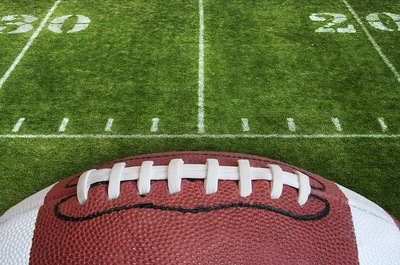 If you are a total newcomer to American football then this guide is just what you need to be able to enjoy watching and perhaps betting on a game.
If you are a total newcomer to American football then this guide is just what you need to be able to enjoy watching and perhaps betting on a game.
If you are planning on staying up late to watch your first-ever Super Bowl, attending one of the NFL’s games at Wembley, or you just want to understand what the hell is going on with this sometimes difficult-to-understand game, our very basic guide is perfect.
Like many sports, American football, what the Americans simply call “football”, or sometimes gridiron, is packed with complexities.
To understand every law, every piece of terminology and the subtleties of tactics and strategy it is necessary to watch the game regularly over many years.
Even then, if it is not a sport you have grown up with and played yourself, it may be difficult to fully understand and appreciate it on all levels.
However, if you just want to get to grips with the basics so you can follow and enjoy a game, we reckon this 10-minute read is the perfect place to start…
Scoring And Basic Gameplay Of American Football
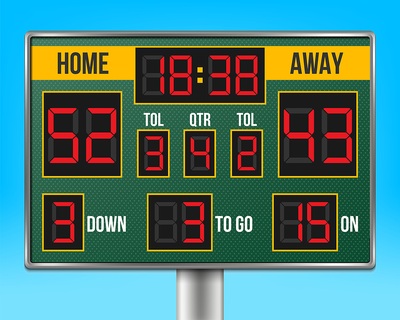 There are a number of similarities between rugby and American football, so if you are familiar with rugby that will help; but if not, it’s not a major problem. The sports take place on similar sized and shaped pitches; rectangles that are roughly 100 yards long. American football pitches are a standardised length and width of exactly 100 yards (360 feet) long by 160 feet wide, with an end zone of 10 yards beyond the posts at either end.
There are a number of similarities between rugby and American football, so if you are familiar with rugby that will help; but if not, it’s not a major problem. The sports take place on similar sized and shaped pitches; rectangles that are roughly 100 yards long. American football pitches are a standardised length and width of exactly 100 yards (360 feet) long by 160 feet wide, with an end zone of 10 yards beyond the posts at either end.
The main aim is to get the ball from one end of the pitch to the other, scoring a touchdown by taking it into the end zone. A touchdown scores six points with a “point after” conversion which is usually a kick worth one point (though teams can opt for a two-point option too that involves running a play – starting – from their opponent’s two-yard line and attempting to get the ball into the end zone again).
Note that, despite its name, a player does not actually need to touch the ball down in the end zone to score a touchdown, they simply need to carry it into or catch it in the end zone (so this is different to rugby in which the ball must be grounded past the goal line to score a try).
The other scoring plays are a field goal which is worth three points, and a safety which is worth two. A field goal entails kicking the ball over the crossbar of the posts, whilst a safety is scored by tackling an attacking player in their own end zone.
As with most ball games, whichever team scores the most points is declared the winner.
The match takes place over four quarters, each lasting 15 minutes. There is a brief interval between quarters and a longer one for half-time after the first two quarters. Because the clock stops for several reasons during a match, games usually last for around three hours, rather than the one hour (plus intervals) that four 15-minute quarters might imply. That said, there will only be 15 minutes per quarter of actual live game time.
Offence Versus Defence
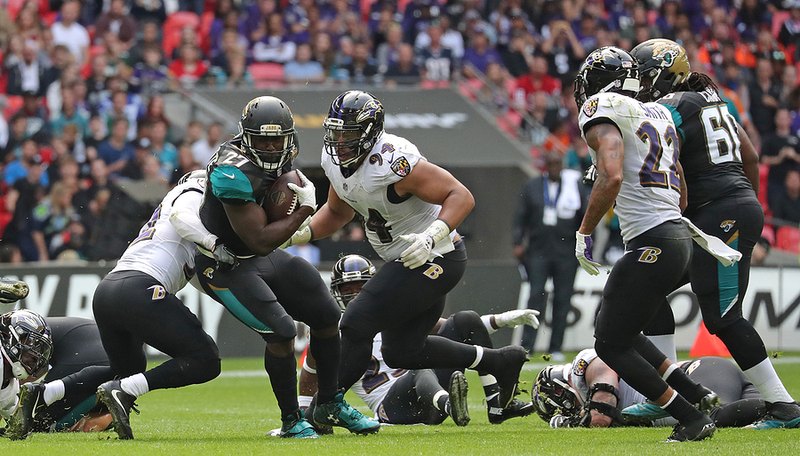
Teams in the National Football League (NFL) – the main American football competition of which the Super Bowl is the “final” – can have 53 players in their squads, of which up to 46 can be in the match day squad. A total of 11 players will be on the pitch from each side at any given moment, with squads divided into three distinct units: offence (pronounced “oh-fence” in a yankee accent), defence (pronounced “dee-fence”) and special teams. Unlimited and rolling substitutions can be made during the course of the match though these must be made during breaks in play, that is, between “downs” (see below).
Most of the time it will be offence versus defence, the former trying to advance the ball into their opponent’s end zone and the latter trying to stop them. Each time a team attacks they have four “downs” in which to advance the ball at least 10 yards or score. A down is a bit like a tackle in rugby league and is sometimes called a play, but is effectively a “go” or “turn” during which a team attempts to move things forwards.
If they manage to move the ball forwards by 10 or more yards they get a fresh set of four downs, starting again at what is called “first down”. This continues until they fail or until they score. If they reach fourth down there will often be a change of strategy and the special teams unit will come into play. Rather than try to achieve the 10-yard advancement needed to earn another first down, they will try to score a field goal, if they are within kicking range, and thus earn three points.
If they are within around 35 yards of the end zone they will normally attempt a field goal of just over 50 yards, the kick usually being around 17 yards longer than the distance from the posts as the ball has to be snapped (passed) back before being held on the ground and then kicked. If they are further away than this then they will typically punt the ball, which means kicking it deep into their opponent’s half to gain a territorial advantage.
Options On Offence
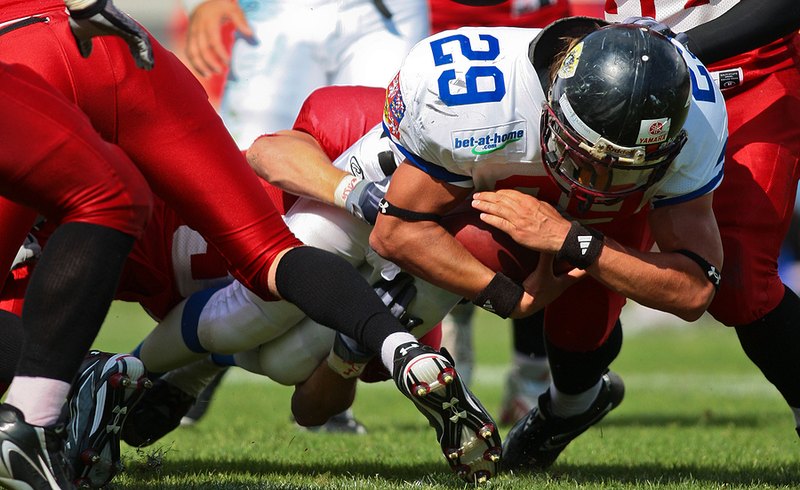
When a team is attacking, they have possession of the ball and are said to be “on offence”. There are two main methods of attacking, either throwing the ball forward to a colleague, or running with it. The ball can only be thrown forward once on each play, or down, and this cannot be done if the ball has gone past the line of scrimmage (pronounced scrummage), which is where it starts at the beginning of each down and where the opposing players line up facing one another. The ball can be passed backwards or sideways as many times as a team wants, although this is not often seen in the professional game.
The quarterback is usually considered to be the most important member of any American football squad, or roster. They are the de facto leader of the team and certainly the key offensive player. The quarterback, or QB, receives the ball from the center at the line of scrimmage and thus the attack begins.
The QB then typically either passes the ball to the running back, if the team has chosen to run the ball, or passes it to a wide receiver if they have decided to attack in that way. That said, other players can run with the ball, including the quarterback, whilst others can also receive a pass, though the named positions are the most important for the specified roles.
Various guards, tackles and ends line up at the line of scrimmage to defend the QB from the opposition defence. They block the defence to give the QB time and space to execute their pass or to open up the play to help the running back or other player gain yards by running with the ball.
In general, running with the ball is a better option when just a few yards are needed to either score or to earn a first down, whereas passing the ball is preferred if the offence needs to make up a lot of ground in one play. That is not always the case though, and passes can be used for a short gain, whilst running attacks can on occasion yield a huge number of yards.
Defence: Roles
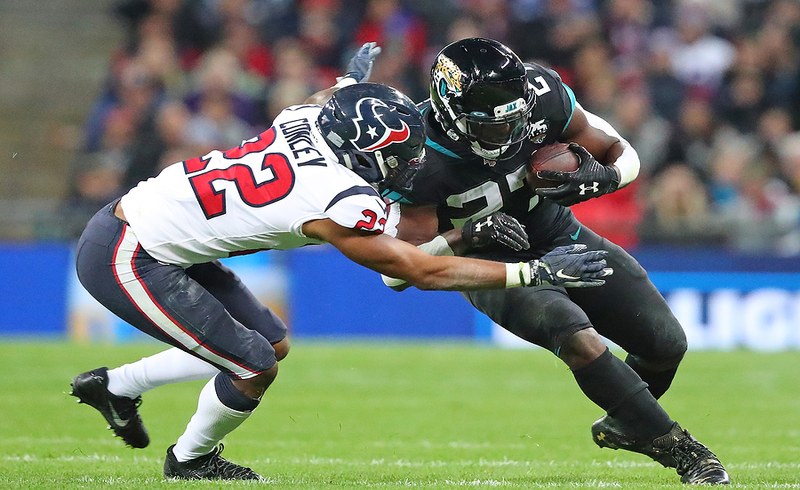
The 11 players on defence are tasked with preventing the offence from advancing the ball. In the short-term this means stopping them advancing the 10 yards necessary to gain a first down, but ultimately they need to stop the offence scoring a touchdown by getting the ball over the goal line and into the end zone. The defensive unit is made up of three groups of players:
- Defensive backs – also known as secondary, these consist of cornerbacks and safeties and these are generally faster, smaller players who try to mark wide receivers and stop them from catching the ball.
- Linebackers – linebackers, as the name might suggest, are effectively hybrid players who can do a little of both roles, working at the line (of scrimmage) and the backfield. This means they can act as extra linemen trying to block and attack the QB, or as extra pass protection. They also act as defensive leaders and relay decisions as to how the team will defend a given play. They are also classed as part of the secondary.
- Defensive line – the defensive line is made up of the biggest players on defence and there are usually four players at the line of scrimmage. They attempt to get the better of their opponents in the offensive line and either reach the quarterback or tackle any player trying to run with the ball.
As well as attempting to stop the offence from advancing and ultimately scoring, the defence is also trying to force a turnover. The most common way of doing this is to stop the opposition from earning a first down and ideally forcing them to punt or, at worst, attempt a field goal (worth three points).
However, the quickest way of doing this is via an interception or fumble. If the defence, usually a member of the secondary, catches one of the offence’s passes, they are said to have intercepted the ball and this earns their side possession of the ball. Alternatively, if a member of the offence has possession of the ball but then drops it, typically under pressure from a member of the defence, this is a fumble.
Either side can recover a fumbled ball and if the defence does so then they assume possession. A defender can try and force a fumble by tackling the ball, or simply tackling the ball carrier very aggressively.
Basic Rules
Now we understand the key roles within the game and the fundamentals of the gameplay, let us consider some of the simpler rules.
Tackles
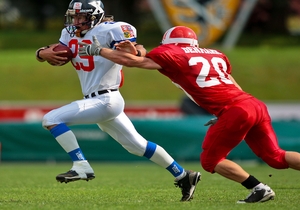 One key thing to note is that only the player carrying the ball can be tackled. This also means that until a receiver actually makes contact with the ball, they cannot be touched. A tackle can be carried out in a wider range of ways than it can in rugby. Players can grab their opponent’s shirt and even hair, they can ankle tap them, use a traditional tackle where they wrap their arms around the player or simply run into their opponent and knock them over.
One key thing to note is that only the player carrying the ball can be tackled. This also means that until a receiver actually makes contact with the ball, they cannot be touched. A tackle can be carried out in a wider range of ways than it can in rugby. Players can grab their opponent’s shirt and even hair, they can ankle tap them, use a traditional tackle where they wrap their arms around the player or simply run into their opponent and knock them over.
Most of the things that are not allowed involve the helmet. Players cannot grab the facemask of an opposition player’s helmet, nor can they use their own helmet to perform a tackle. In addition, a player cannot be grabbed by the padding around their neck, nor “clotheslined” by a high, swinging arm of an opponent.
A tackle is completed when an attacking player’s forward momentum is entirely halted. More typically, it occurs when a part of their body, other than their feet or hands, makes contact with the ground. Lastly, a tackle can be made by forcing a player out of bounds – off the side of the pitch. When any of these things happen, that down is completed and play resumes with the next down.
Blocking
Blocking is a huge part of American football but is distinct from holding, which incurs a foul. If you grab or hold any player other than the one in possession of the ball, a foul will be awarded. Blocks cannot be made into another player’s back, nor the backs of their legs.
Timing
 As said, there are four quarters of 15 minutes, with teams changing ends after each. There is a short interval of just two minutes after the first and third quarters and a longer half-time of 12 minutes after the second quarter. After the first and third quarters, the side in possession retains the ball and continues their attack, whilst at half-time play resumes with one side kicking the ball to the other, as in rugby.
As said, there are four quarters of 15 minutes, with teams changing ends after each. There is a short interval of just two minutes after the first and third quarters and a longer half-time of 12 minutes after the second quarter. After the first and third quarters, the side in possession retains the ball and continues their attack, whilst at half-time play resumes with one side kicking the ball to the other, as in rugby.
The play clock stops when a player is tackled, out of bounds or if a foul is awarded (indicated by one of the seven officials, led by the referee, throwing a yellow flag, akin to a hankie, onto the ground). The clock is also stopped by an incomplete pass, which is when the offence throws the ball forward and it is not caught by either side.
In addition, either side can call a timeout which also stops the clock and gives both sides two minutes to rest, discuss tactics or simply break up play, for instance, if the opposition is enjoying a good patch of play. Both sides get three timeouts per half.
Overtime
In common with most US sports, draws are not something we often see in American football. All games in the NFL advance to overtime (OT), which is the equivalent of extra time in rugby and football, if the scores are level at full time. This is semi-sudden death, in that if the first side in possession scores a touchdown, they win, whilst a safety for the team on defence also yields an instant win.
If the first score is a field goal, the opposition gets a chance to reply but must do so on their first possession. If they score a TD, they win, whilst a field goal then leads to sudden death.
The rules for OT have been tweaked and amended over the years but currently, if the game is undecided after a 10-minute period of play it is recorded as a tie during the regular season. In the playoffs or post-season, overtime consists of 15-minute passages of play until a winner is decided.
League Structure And Road To Super Bowl
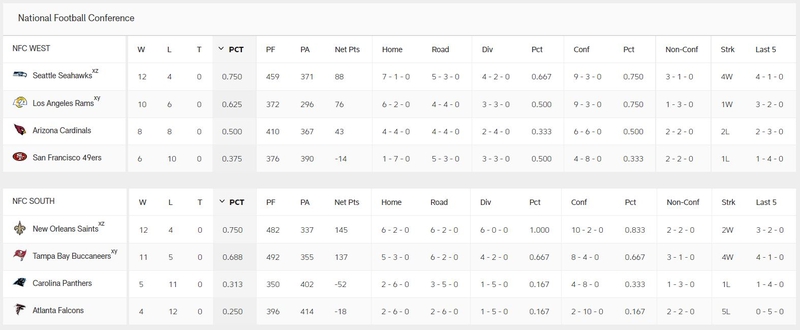
The NFL is divided into two Conferences, the American Football Conference (AFC) and the National Football Conference (NFC). Each has a North, South, West and East Division, with four teams in each, so 32 teams in total. Each plays 17 games over 18 weeks during the regular season from September to January. They play the teams in their own division at home and away, with the remaining games against a mix of sides from their own conference and from the opposite one.
14 teams advance to the post-season, which runs from January until the Super Bowl on the first Sunday in February. That is made up of seven from each conference and all are seeded according to how they performed. This includes the eight divisional winners, plus three wild cards from each conference, those sides being the ones with the best overall records out of the remaining teams. The top team from each conference gets a bye in wild card week, whilst the other three division winners each face one of the wild card teams.
The victors of the wild card games meet in the Divisional Round, again according to seedings, with the lowest-seeded side facing the team who received the bye. The winners of these games meet in the Conference Championship, the higher seed playing at home, with the winner of this clash going on to the Super Bowl itself.
In the post-season sides only play teams from within their own Conference, ensuring the NFL’s showpiece occasion is always an NFC versus AFC affair. The first-ever Super Bowl was back in 1967 and was won by the Green Bay Packers. Super Bowls use Roman numerals, so that was Super Bowl I, with Super Bowl LV (55) being won by Tampa Bay Buccaneers in 2021 as the culmination of the 2020 season.
We hope that’s given you a decent insight into how American football – and the NFL – works. If you want to learn more about this intriguing and entertaining sport, we’d certainly recommend you watch a few games and you’ll soon start to pick up some of the more nuanced rules and tactics employed.
